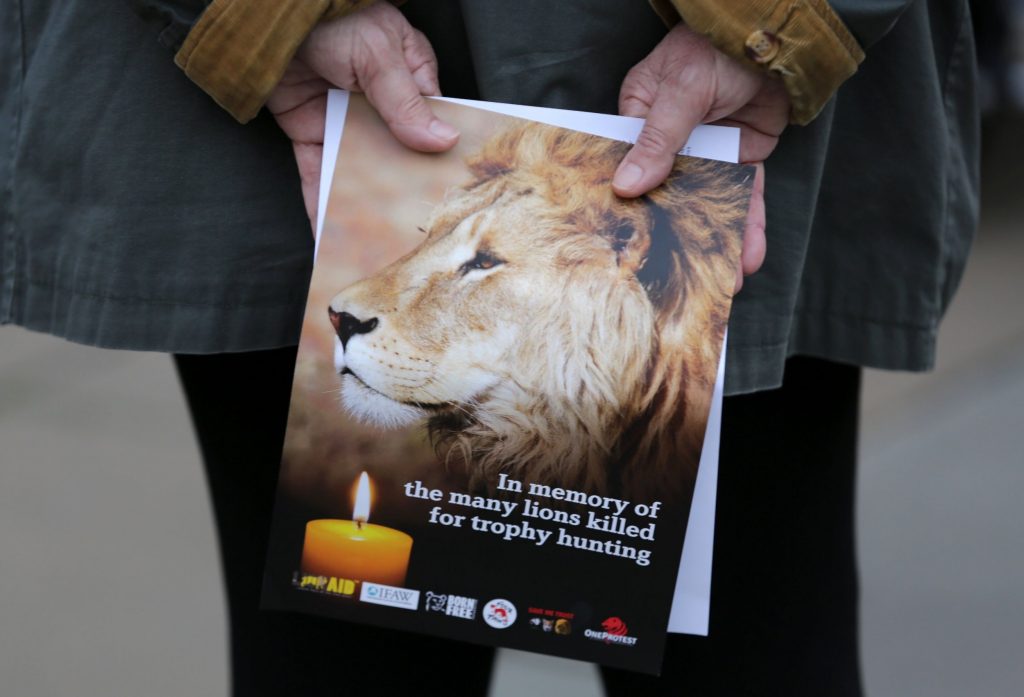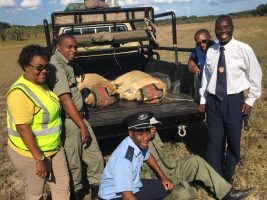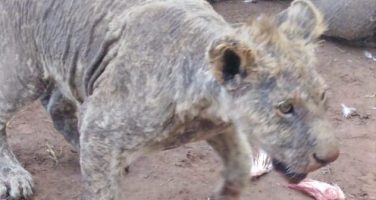We remember CECIL the Lion!
In 2015, CECIL the lion was shot with a crossbow by the trophy hunter, Walter Palmer. His last 11 hours were lived in pain and suffering.

When Walter Palmer, the Minnesota dentist and avid trophy hunter, killed Cecil the Lion in July 2015, the incident ignited a furore. For Oxford University biologist Andrew Loveridge, who had been studying Cecil for the past eight years, it was devastating.
An excerpt of Lion Hearted:
The Life and Death of Cecil and the Future of Africa’s Iconic Cats – Andrew Loveridge – REGAN ARTS
Cecil, the 12-year-old male lion, padded along the dirt track with leisurely strides, soundless except for the crystal scratch of sand under his soup plate–size feet. His coal-black mane proclaimed his status as the undisputed king of this part of the savanna. He paused only to scent-spray roadside bushes, maintaining his domain’s signposts in a routine he had followed every night since he had become a territorial male nearly a decade before. He underlined his aromatic signature with vigorous scrapes of his hind paws.
The scent of a dead elephant drew the lion forward, enticing him to what long experience had taught him was another free meal. He had often fed on elephants. But there was something different about this carcass, something beyond this cat’s experience of things to avoid. He could sense the presence of humans. No matter how quiet we think we are, or how little scent we think we exude, animals pick up the tiniest cues. The rustle of clothing, the smell of toothpaste and deodorant, gun oil and plastic—they all stand out in a wild animal’s sensory world like a snowflake in a coal mine.
Humans didn’t worry about Cecil.
He was used to their scent from years of living in a prime photographic safari concession in the park. But these were not the humans he knew. To minimize the scent and sound that would drift across the clearing, these humans were hiding in a tree platform downwind of the carcass. Crouched on a small platform was an American with a broad, white smile, a powerful compound bow, and a quiver full of lethally sharp arrows. He was flanked by a stocky Zimbabwean guide. It would have been freezing cold to sit agonizingly still in the cramped hide, but the hunters would have comforted themselves that the wait wouldn’t be long. This was an easy lion to hunt—a park lion, well-fed and habituated to people.
The big cat sniffed the clearing. The draw of the elephant meat overcame the lion’s caution, and he approached the carcass. He settled down to feed, tearing at the tough, dry meat with scissor-like teeth. He fed for a few minutes, oblivious to the hunter taking up the tension on his bow.
The Hwange RESEARCH PROJECT STAFF
only became aware that something was amiss six days later. Project field assistant Brent Stapelkamp routinely checked all the GPS downloads from the satellite collars we’d fitted on the study lions. He noticed Cecil’s satellite collar hadn’t transmitted any data since July 4.
…………………………….
Subsequent positions sent from Cecil’s collar show that he moved in a southeasterly direction until 7 a.m. on July 2. In about eight hours, the wounded animal had moved only 160 meters from where he’d been shot. Eventually, Bronkhorst, the hunting outfitter, advised Palmer to “finish the lion off.” If Bronkhorst’s later statements are accurate, the hunters went to administer a coup de grace at around 9 a.m.
They went off in the vehicle to find the lion.
According to the collar’s GPS data, by now, Cecil had moved a distance of about 350 meters from the point where he was wounded. A second arrow killed Cecil. Bronkhorst and Palmer returned to the hunting blind about 45 minutes later with the dead lion in the back of the hunting vehicle.
In media reports, it was widely touted that Cecil suffered in agony for 40 hours. He’d unlikely have lived that long with such a severe thoracic injury. However, he most definitely did not die instantly and almost certainly suffered considerably. Judging from the data sent by the GPS collar, the injured lion most likely was killed 10 to 12 hours after being wounded.
Cecil the Lion was a commodity to be collected.
The most difficult about the whole incident is the apparent callousness with which the hunters undertook this hunt. Concern for the pain and suffering of the animal never seems to have been a particular consideration. The thought of killing any animal purely for sport or pleasure is abhorrent. If it has to happen, it must be done cleanly and without undue stress or suffering.
Cecil suffered incredible cruelty for at least 10 hours, severely wounded and slowly dying. The Lion was heard “struggling to breathe”. Although the wound was severe, the arrow had missed the vital organs. It missed arteries that would have caused rapid blood loss and relatively quick death. Cecil, in all those hours, was only able to move only 350 meters from the place where he was shot.
To kill a quarry animal quickly and efficiently is the hallmark of a good hunter. Indeed, Palmer had allowed a mortally wounded animal to suffer for more than 10 hours before attempting a final kill.
Palmer hoped to submit this large trophy to a hunting record book as a bow-hunted specimen.
One possibility is that the hunters were content to leave the lion to die from its first catastrophic injury. When the lion didn’t oblige them, they were presented hours later with the inconvenience of shooting it with another arrow. Cecil the lion died slowly and painfully. He died slowly to allow Palmer to claim he had killed a huge lion with a bow and arrow.
Andrew Loveridge is one of the lead researchers in a team studying lions in the Hwange area. 42 of their collared male study animals have been trophy-hunted since the research began in 1999.
If you see or hear anything that doesn’t seem right, please report it to us so we can investigate further.







